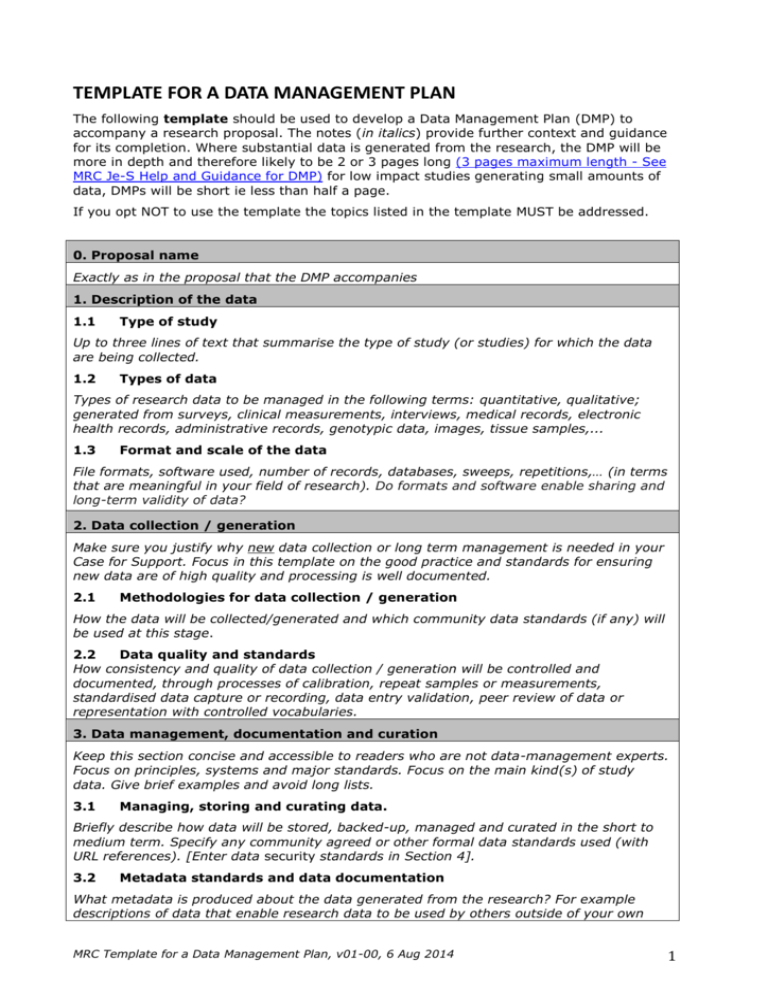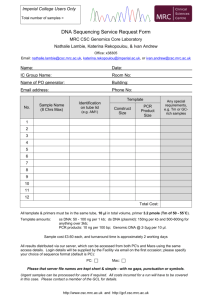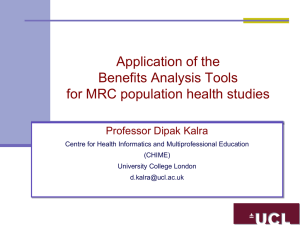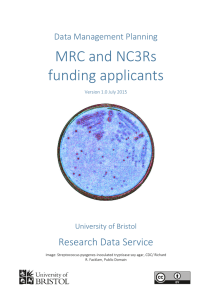Data Management Plan Template for Research Proposals
advertisement

TEMPLATE FOR A DATA MANAGEMENT PLAN The following template should be used to develop a Data Management Plan (DMP) to accompany a research proposal. The notes (in italics) provide further context and guidance for its completion. Where substantial data is generated from the research, the DMP will be more in depth and therefore likely to be 2 or 3 pages long (3 pages maximum length - See MRC Je-S Help and Guidance for DMP) for low impact studies generating small amounts of data, DMPs will be short ie less than half a page. If you opt NOT to use the template the topics listed in the template MUST be addressed. 0. Proposal name Exactly as in the proposal that the DMP accompanies 1. Description of the data 1.1 Type of study Up to three lines of text that summarise the type of study (or studies) for which the data are being collected. 1.2 Types of data Types of research data to be managed in the following terms: quantitative, qualitative; generated from surveys, clinical measurements, interviews, medical records, electronic health records, administrative records, genotypic data, images, tissue samples,... 1.3 Format and scale of the data File formats, software used, number of records, databases, sweeps, repetitions,… (in terms that are meaningful in your field of research). Do formats and software enable sharing and long-term validity of data? 2. Data collection / generation Make sure you justify why new data collection or long term management is needed in your Case for Support. Focus in this template on the good practice and standards for ensuring new data are of high quality and processing is well documented. 2.1 Methodologies for data collection / generation How the data will be collected/generated and which community data standards (if any) will be used at this stage. 2.2 Data quality and standards How consistency and quality of data collection / generation will be controlled and documented, through processes of calibration, repeat samples or measurements, standardised data capture or recording, data entry validation, peer review of data or representation with controlled vocabularies. 3. Data management, documentation and curation Keep this section concise and accessible to readers who are not data-management experts. Focus on principles, systems and major standards. Focus on the main kind(s) of study data. Give brief examples and avoid long lists. 3.1 Managing, storing and curating data. Briefly describe how data will be stored, backed-up, managed and curated in the short to medium term. Specify any community agreed or other formal data standards used (with URL references). [Enter data security standards in Section 4]. 3.2 Metadata standards and data documentation What metadata is produced about the data generated from the research? For example descriptions of data that enable research data to be used by others outside of your own MRC Template for a Data Management Plan, v01-00, 6 Aug 2014 1 team. This may include documenting the methods used to generate the data, analytical and procedural information, capturing instrument metadata alongside data, documenting provenance of data and their coding, detailed descriptions for variables, records, etc. 3.3 Data preservation strategy and standards Plans and place for long-term storage, preservation and planned retention period for the research data. Formal preservation standards, if any. Indicate which data may not be retained (if any). 4. Data security and confidentiality of potentially disclosive information This section MUST be completed if your research data includes personal data relating to human participants in research. For other research, the safeguarding and security of data should also be considered. Information provided will be in line with you ethical review. Please note this section concerns protecting the data, not the patients. 4.1 Formal information/data security standards Identify formal information standards with which your study is or will be compliant. An example is ISO 27001.If your organisation is ISO compliant, please state the registration number. 4.2 Main risks to data security All personal data has an element of risk. , Summarise the main risks to the confidentiality and security of information related to human participants, the level of risk and how these risks will be managed. Cover the main processes or facilities for storage and processing of personal data, data access, with controls put in place and any auditing of user compliance with consent and security conditions. It is not sufficient to write not applicable under this heading. MRC guidance on the Confidentiality and data security is provided (please see page 24 of the PDF file generated by selecting the above or adjacent link). 5. Data sharing and access Identify any data repository (-ies) that are, or will be, entrusted with storing, curating and/or sharing data from your study, where they exist for particular disciplinary domains or data types. Information on repositories is available here. 5.1 Suitability for sharing Is the data you propose to collect (or existing data you propose to use) in the study suitable for sharing? If yes, briefly state why it is suitable. If No, indicate why the data will not be suitable for sharing and then go to Section 6. 5.2 Discovery by potential users of the research data Indicate how potential new users (outside of your organisation) can find out about your data and identify whether it could be suitable for their research purposes, e.g. through summary information (metadata) being readily available on the study website, in the MRC gateway for population and patient research data, or in other databases or catalogues. How widely accessible is this depository? Indicate whether your policy or approach to data sharing is (or will be) published on your study website (or by other means). 5.3 Governance of access Identify who makes or will make the decision on whether to supply research data to a potential new user. For population health and patient-based research, indicate how independent oversight of data access and sharing (please see page 10 of PDF file generated by selecting the above or adjacent link) works (or will work) in compliance with MRC policy. Indicate whether the research data will be deposited in and available from an identified community database, repository, archive or other infrastructure established to curate and MRC Template for a Data Management Plan, v01-00, 6 Aug 2014 2 share data. 5.4 The study team’s exclusive use of the data MRC’s requirement is for timely data sharing, with the understanding that a limited, defined period of exclusive use of data for primary research is reasonable according to the nature and value of the data, and that this restriction on sharing should be based on simple, clear principles. What are the timescale/dependencies for when data will be accessible to others outside of your team? Summarize the principles of your current/intended policy. 5.5 Restrictions or delays to sharing, with planned actions to limit such restrictions Restriction to data sharing may be due to participant confidentiality, consent agreements or IPR. Strategies to limit restrictions may include data being anonymised or aggregated; gaining participant consent for data sharing; gaining copyright permissions. For prospective studies, consent procedures should include provision for data sharing to maximise the value of the data for wider research use, while providing adequate safeguards for participants. As part of the consent process, proposed procedures for data sharing should be set out clearly and current and potential future risks associated with this explained to research participants. 5.6 Regulation of responsibilities of users Indicate whether external users are (will be) bound by data sharing agreements, setting out their main responsibilities (please see page 13 section 7, titled Data-sharing agreements of the PDF file generated by selecting either of two links above). 6. Responsibilities Apart from the PI, who is responsible at your organisation/within your consortia for: study-wide data management metadata creation, data security quality assurance of data. 7. Relevant institutional, departmental or study policies on data sharing and data security Please complete, where such policies are (i) relevant to your study, and (ii) are in the public domain, e.g. accessible through the internet. Add any others that are relevant Policy URL or Reference Data Management Policy & Procedures Data Security Policy Data Sharing Policy e.g. a study policy of sharing research data Institutional Information Policy Other: Other 8. Author of this Data Management Plan (Name) and, if different to that of the Principal Investigator, their telephone & email contact details MRC Template for a Data Management Plan, v01-00, 6 Aug 2014 3








